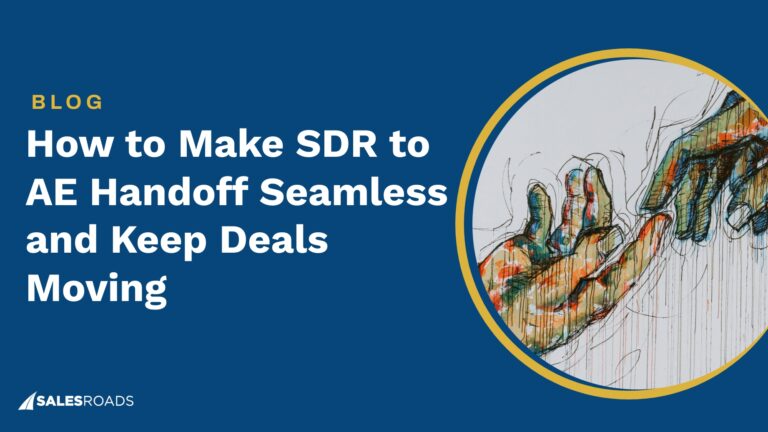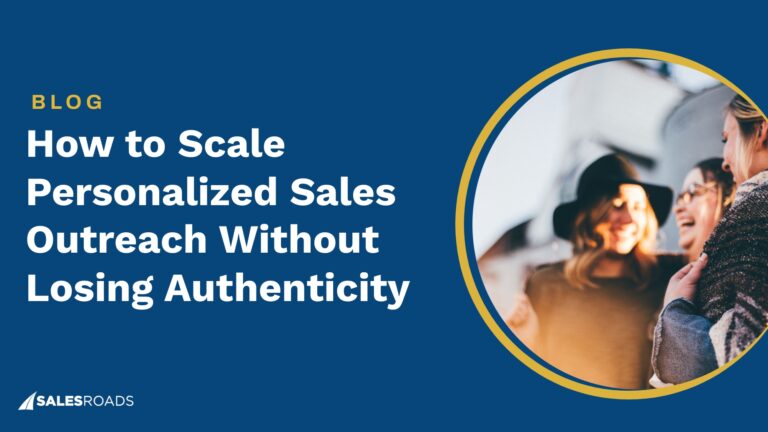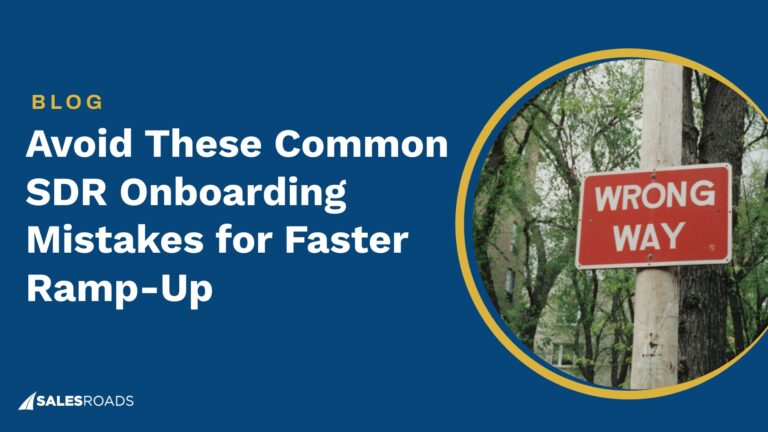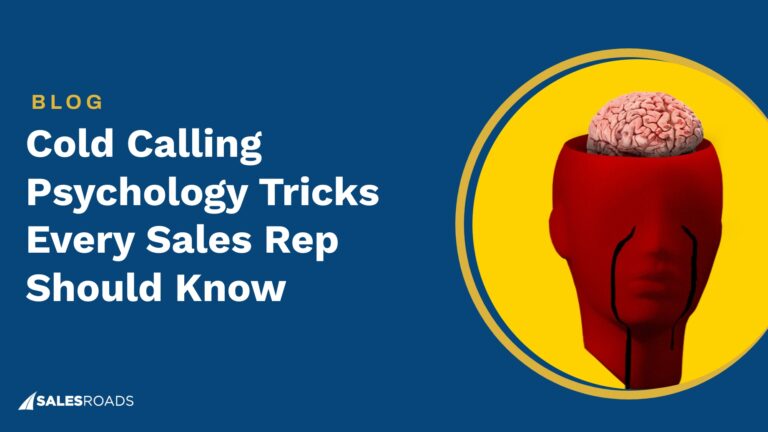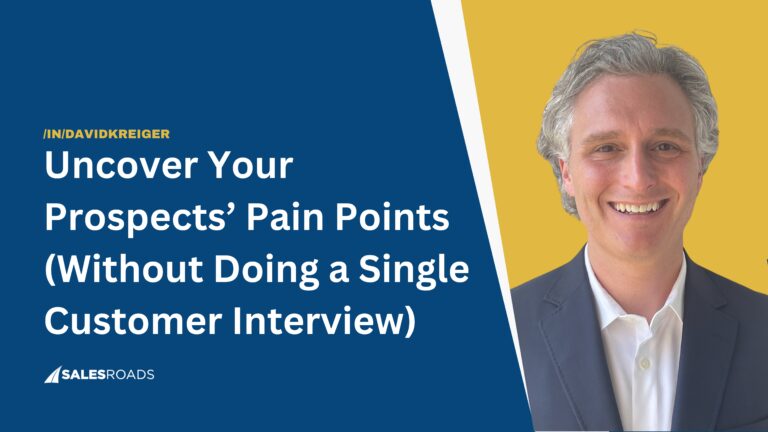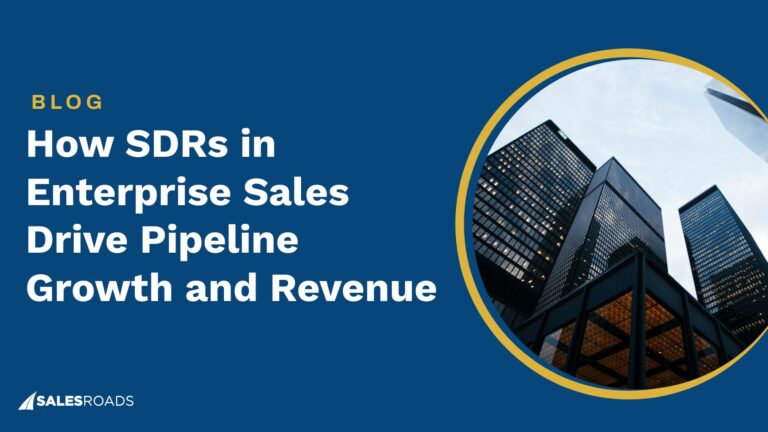Sell Like A Leader – Episode 21
In this episode, we dive into:
– B2B Sales Fundamentals: The challenges for sales leaders and their teams in 2024 and what’s going to look like for 2025, how to structure the prospecting function, the concept of propensity data, getting the entire org to collaborate, talking about the product vs. learning about the buyer business’ problems, how to instill business acumen in your sales reps so they can better understand the business context, presenting pricing as a story, modeling the sales behaviors you want to see as a leader, questions for team reviews, the metrics you can’t miss in your dashboard, time management in sales, skill adjustments to help SDRs, how sales managers should be supporting AEs, hiring BDRs from your SDRs, the dark side of tools being used these days by SDRs, the best uses for AI and making the case for call recording.
– Rapid Fire Q&A
About Mike Kavanagh
David Kreiger chats with Mike Kavanagh, VP of Commercial Sales N. America for OneTrust, a leader in data privacy and consent management. He has been in B2B sales for 16+ years and transitioned into sales management about 10 years ago. During that time, he led Enterprise sales teams, partner teams, and cross-functional teams including marketing, customer success, and operations.
Podcast Key Takeaways
- The ‘zero-interest period’ saw easier spending, leading sales teams to focus on selling features and functionalities. However, the current economic climate demands a return to addressing significant business problems due to tighter budgets.
- Sales teams need to uncover big, fundamental problems that compel businesses to act. Sales should solve problems that drive revenue or reduce costs significantly.
- Mike highlights the importance of training new salespeople on business fundamentals: Understanding the client’s business; framing the impact of their problems in a business context; and recognizing the buying process in the client’s organization.
- Sales leadership should actively engage in client calls, modeling good sales behavior.
Connects
Connect with Mike Kavanagh: https://www.linkedin.com/in/mikejkavanagh
Connect with David Kreiger: https://www.linkedin.com/in/davidkreiger
Subscribe to the podcast and follow our Podcast LinkedIn page so you don’t miss any episodes!
Transcript
David: Welcome back to another episode of the Sell Like a Leader podcast, the podcast for revenue leaders who are on a mission to cultivate a high-performing sales team. I'm your host, David Kreiger, founder of SalesRoads, America's most trusted sales outsourcing and appointment setting company. Today, we bring you another great revenue leader, Mike Kavanagh.
Mike is currently the VP of Commercial Sales for North America for OneTrust, which is a leader in data privacy and consent management. So really excited to talk to him about his learnings, about where we find ourselves in B2B sales currently, and his perspective on the market. Let us jump in. Welcome, Mike.
Mike: Thanks for having me, David. I appreciate it.
David: Yeah, great to have you here. And I wanted to start out, you had told us during the research phase for this podcast that you see the B2B sales in 2024 have been [00:01:00] about getting back to strong fundamentals and feel that 2025 is going to be the same. Can you just unpack that for our listeners?
Mike: I think a lot of salespeople—younger salespeople—got into sales in the zero-interest period where money was flowing and companies were buying very rapidly, especially SaaS companies. Anybody could buy anything to solve a maybe small, second, or third-degree problem.
Obviously, the climate has changed, the economics have changed, and I think it's actually for the best. As I said, I started my sales career during '07, '08, during the last recession. And we really had to help discover what the problems were and how we're going to solve those problems.
And they had to be big, meatier problems to the business because budgets were finite. You were going to have to go to the CFO. And I think that's what we're back to. We got a little too comfortable selling on feature and functionality and not really unpacking what was going on in the business and driving to why do they need to do something now?
Why [00:02:00] do they need to cut a check to do this now? What happens if they don't do it now, right? These fundamental questions—not about the capabilities of whatever you're selling—but what are the business problems that you're solving for or trying to solve for? No one is spending anything right now unless it can really help reduce costs or increase revenue.
That's the most important thing right now and you have to have a really strong business case when you go in front of a CFO or even a CEO for those types of justifications.
David: Yeah, I agree that it actually is in many ways for the best. I think both for companies, right? That was a crazy time in 2021.
Mike: It was fun.
David: Yeah.
Mike: Great.
David: It definitely was fun. You could ring the bell a lot of times, but you weren't necessarily solving real problems, which is what—I shouldn't say solving real problems. I think the way you'd framed it is better. Second degree, third degree problems.
And at the end of the day, sales is about solving those big problems for our clients, which is what sales... I like how you're framing this and to [00:03:00] that effect, as you are leading a team and trying to get people back to the fundamentals, what are the challenges that you find in establishing that mindset amongst your team or your organization? And, you know, where do you start with that? And that's tough.
Mike: Sure. So, OneTrust is a great organization. It's been around since 2016. Almost half a billion dollars in revenue, 14,000-plus customers across the globe, a leader in this space. And we grew very rapidly in eight years. But with that, I think again, we have young—I have a younger set of salespeople early in their career.
And we were very fortunate that people—we're a market leader, we're recognized as a leader in this space. And so the sales reps got comfortable with people coming to them and saying, "Hey, I have to solve this. This is why, and I just need to make sure that you can do X, Y, and Z."
The challenge now is that we're doing more outbound. It's a more competitive landscape. And I think the biggest thing that [00:04:00] I try and reinforce with all the salespeople in my org is: Why are they going to do this now? Have we really uncovered what has suddenly changed in their business that they're now prepared to invest in something that we're selling?
The privacy laws like GDPR in EMEA, some of the things in California, Massachusetts, New York, Texas—those have been around for quite a while now, or have been for a while. What's changing in their business? Have they been fined by a legal entity? Have they been sued? But what is driving the desire to change?
Why are they taking this call with you? And then taking a step further to say, okay, what's the impact? What impact is this having on the business?
And is it significant enough that your CFO has said, yes, we're going to go carve out money, resources, time to solve it. And I think helping young salespeople early in their [00:05:00] career really become better at having the business conversation is important. I think I've got a great sales team. They know the product inside and out.
I always joke with them: if I'm ever answering product questions on the call, we have a problem, right? But they're very comfortable talking about the product.
We have to get better about understanding the business context and helping peel back what's driving this conversation from a business standpoint.
David: That doesn't have necessarily the business acumen. Maybe they have some sales instincts. They've been in things. So how do you—is it a training program? Is it a coaching? Is it a mentorship? Like, how do you instill some of those types of business acumen aspects to your—
Mike: Yeah. I think that's a great question. And I'm very fortunate—I started my sales career at AT&T, and they shipped me down to Atlanta for six months. They put us through six months of classes [00:06:00] about the technology, about business, about how to present properly, value propositions—all those things.
I had six months, which really accelerated my career. There's not a lot of SaaS companies that make that type of investment. So I try and distill it down to having a very clear expectation of what does a good deal look like in doing deal reviews.
Actually, I just got off a deal review with one of my teams where we really—we have three slides. They put the slides together, and it really focuses on: What does the company do? How do they make money? What is the business problem they're trying to solve for? Do we have KPIs? Do we have specific metrics that would say we're improving or in any sense for them? And do they understand the buying process at this company?
I think if we can distill it down to those core things, right? Do we understand this business? Do we understand the impact of the problem we're solving? And do we [00:07:00] understand who's going to be involved in this process?
We define commercial in a very broad spectrum. So anything in our space, zero to a billion dollars, is considered commercial. So one day they could be talking to a hundred-person company. The next day, they could be talking to a multi-thousand-employee multinational company. So we're changing that a little bit.
But really having set questions and setting expectations of, "Hey, this is how we structure a good deal."
And I'm a big believer—I tell the AEs all the time that work for me—I'm better off being on a call with you in front of a customer versus being behind the scenes looking at Salesforce data and finding where their problems are. So I'm a big believer that we need to get out and show—senior sales leaders should have to get back out there and show some of these AEs what good looks like, right?
David: Yeah, that's great to really model the behavior, and they learn through osmosis in.
Mike: Yeah.
David: So that can be very [00:08:00] powerful. So one of the things that you brought up earlier is now in this dynamic where you don't necessarily have as many companies coming to you and just asking a few product questions to make sure that you check the box, and then they're ready to sign up.
You got to do more of an outbound motion. You got to go find those companies that have that pain, that have an issue that you guys are well positioned to solve. And so can you tell us a little bit about how you guys structure the prospecting function?
Mike: Yeah. So our fiscal year goes February to January. So we're just about wrapped up here in Q4. We got one more month. And we're heavily into FY26 planning. We have some new sales leadership.
And one of the things we're doing for the first time is propensity data and talking about, instead of the spray and pray methodology, saying, "Hey, here are the industries and the personas that are most receptive to our message." [00:09:00]
A collaboration across the entire organization. It's not just a sales or a BDR function or a marketing function. It is a cross-functional requirement for everybody, from getting proper messaging for proper product marketing and marketing to making sure our systems and tools are aligned to make it easy.
But I think really having the propensity to say, okay, here’s who we sell to, here are the prospects within your territory that are looking at our website, that are looking at key topics in our space, that have visited, that have maybe shown interest in us before.
So that's the first, and then within our existing customers, because our AEs are a hybrid, they have existing and new business targets, to look at our existing base and say, okay, they have these products. What other products should we be talking to them about based on their persona and profile?
I think often, sales—any company says, all right, we're just going to go do outbound, and they dump a bunch of data [00:10:00] accounts, contacts into Salesforce and say, all right, salespeople go. And I, that's not the way to do it.
And it's also, I think it's really important to teach again these AEs who haven't had to do outbound prospecting before, where leads were coming in, and it was—I don't want to say it was order taking, but it was easier. We really have to show them, like, this is what good looks like.
I know a lot of people work at Salesloft and Outreach, and Gong. I don't want to upset any of them, but I do think some of these tools did become a little destructive to outbound sales. They made it too easy for mass messaging from SDRs and BDRs. Less is more. I talk to the team about quality over quantity all the time.
And key metrics to say, all right, how many meetings are we getting in? From those meetings, how many opportunities are we generating?
David: Yeah, I think there is a thought process around some of those tools that really just unfortunately, made SDRs not have to think or not have to work hard and just press a button and hope that sales or appointments fall out.
Mike: I wish to [00:11:00] God, I had ZoomInfo and Outreach or Salesloft when I was in. I had a BlackBerry and a spreadsheet, right? I certainly would have taken those tools, but I think they've created some less-than-ideal habits. And so again, it's on the shoulders of us who've been around a while to again model and help show them what good looks like.
David: Yeah, because I think to your point, those tools can be used well and can lead to tremendous efficiencies, but when they're used wrong, in some ways, it's better to have a spreadsheet and a BlackBerry. And I actually think that we're seeing that dynamic appear again with AI.
And I think AI can make us so much more effective, but again, people love to take the shortcut and just have it write your emails or not really do research. And so I think these tools are a double-edged sword. When they're used correctly, they're amazing. When they're not, they make you actually less productive.
Mike: Yeah. I think any person in our position has gotten hit up by an AI [00:12:00] bot or AI SDR, and I immediately know—and it's somewhat of a turnoff. I can tell that it's getting better. The technology is certainly getting better, but it doesn't sound natural.
My belief with AI is that it's best used for account research—quickly summarizing what's going on in that business, what's available—and then maybe crafting an outline of an email, but it has to be touched by a human.
I think AI should be used for eliminating the mundane tasks that salespeople do. I'm tired of yelling at AEs to update Salesforce. They're tired of me yelling at them to do it. So we can eliminate that. I'm also a big believer in using AI and these things for call coaching and call recording. I think those are tremendous weapons to help these young AEs. I'm convinced I'm still going to have a sales job in 10 or 20 years if I'm still doing this.
David: You alluded to doing—you know—potentially having AI do, listen to sales calls, but I guess zooming out, how are you having your sales [00:13:00] managers support your SDRs on a day-to-day basis? Make sure that they get the coaching, make sure that they are doing the right type of research, that they are going deep instead of broad. Like, how does that structure look like underneath you?
Mike: I've been here since the very end of July, so still putting a lot of this in place. I think with the AE, one thing I'm working on for next year is balancing out the territories and the teams. So no manager has more than seven or eight AEs. After that, it's just impossible to manage.
And then giving a structure to the week. Do a team call. Review last week's performance. Highlight, hey, these are the things we're focusing on this week. Celebrate the wins. Maybe some enablement you want to do—helping them structure a forecast call.
Cause I have managers who’ve not been managers before. So, trying to—like—here's how you run a forecast call. Giving them prescribed questions to ask so everybody knows what they need to know about: hey, is this deal real? Is it moving forward? And then setting [00:14:00] up, here's what I expect from one-on-ones.
I'm pushing right now, truthfully, to get call recording because we don't have that at my current organization. And I think it'll be a tremendous help because we've done a great job of promoting SDRs to BDRs and now BDRs into my organization as AEs.
They're great at doing some light discovery, but tightening up that discovery and then really prescribing, instead of taking the customer's next steps, saying, hey, this is how we prescribe the process for you properly. I think that's a big part of it as well.
David: Yeah. And you have the SDRs do that part of the sales process?
Mike: I don't manage the SDRs. But one thing that we do—my managers and I—we meet with the SDR manager who's handling our inbound flow to say, okay, here's what converted. Here's what you guys scheduled meetings for.
But then we also have meetings with our BDRs, who are only doing outbound prospecting. And again, getting that continuous feedback loop: hey, here are the good [00:15:00] meetings you booked—let's get more of those. And then the feedback loop of, hey, here's the ones that you scheduled. We're not going to move these forward, and here's why. Here's where there's not alignment.
Because I treat the SDR/BDR function as the minor leagues. That's where I want to hire from. It's going to be faster and easier for me to ramp somebody from a BDR role, who's been here for six to twelve months, into an AE role. Cause they're going to know the right discovery questions. They're going to know some of our value prop. Then it's my responsibility and my management team's responsibility to teach them, all right, how do you do a demo? How do we get this leveraging your SC, moving a deal forward through the paper process.
I'm a very big believer in having that collaboration with the SDR/BDR leadership.
David: Let's talk a little bit about metrics. Can you walk us through your team's dashboard and how are you looking at those metrics in 2025?
Mike: Yeah. I mean, we have a great sales operations team—a number of ex-Salesforce people—so I've [00:16:00] got every dashboard conceivable. To the extent where I'm like, hey, we don't need all of these pieces.
To me, obviously, the first metric is: where are you month-to-date, quarter-to-date, etc., right? Like how much have we closed? That to me is the health—you know, we're doing the job. Now, let's peel it back. So I'm always looking at like, how much have we created with a close date in the quarter?
So that's a good metric for us. And then how much are we bringing into the quarter from our previous quarter? I look at pipeline creation, both for in-quarter and quarters out. I then look at pipeline progression. When you think about sales, it's really about three things, right? It's creating pipeline. It's progressing pipeline. And it's closing pipeline.
Those are the three metrics. Now there's a lot more detail I can unpack into those levels, but that's how I look at the week. Are we creating enough pipeline and progressing enough to hit those metrics?
Before OneTrust, I spent two and a half-ish years at Zendesk, in our SMB business, which is a high-velocity, high-volume business. And that was a [00:17:00] big part and a great opportunity for me to learn. I hadn’t traditionally done that, but that's how I break it down.
When I see AEs or management teams missing those metrics, I start to peel it back another layer. I'm not one to prescribe, hey, you need to make 50 phone calls and a hundred emails a day or whatever, because the tools have made it easy to do that. What I want to see is how are you creating good pipeline and progressing it?
So if I see an AE or a manager, I’ll help my managers zero in on AEs who aren't living up to their potential. I'll look at, all right, how much have they closed? They're not closing enough. Okay, are they creating enough pipeline? Yes. Great. Where is it stalling? And we figure out—is it in the demo phase? Is it in the negotiation phase?
Because then it's about skill adjustment, right? If they're creating pipeline and it's stalling out or closing lost, there's something we're missing and we can help sharpen those skills. If we're not creating enough pipeline, now it becomes an activity metric.
I'll [00:18:00] go and look, I'll say, all right, how many calls, how many emails are they making, et cetera, et cetera, right? If the activity levels are high, I have to be somewhat skeptical now because it's gotten so easy. But if they're making genuine calls and sending emails, then you have to look at the emails and see the content they're sending.
Are they being engaging? Are they personalizing the emails enough to get an executive's attention? Now, if there's none of that activity, now we have another problem that we have to talk about. Now it's a will versus a skill question. And I used to do this at Zendesk a lot and I've done it at OneTrust.
And it can make AEs a little nervous, but if somebody's underperforming, I want to help them. That's what I'm passionate about now. I really do enjoy working with this younger group of salespeople because they want to learn. I'll get on and I'll look at their calendars with them and I'll say, all right, what did you do today?
And like time blocking and having a plan, not just putting blocks like, hey, I'm going to prospect. Good. Who are you [00:19:00] prospecting to in that box? Do you have your list of prospect accounts? Do you have your list of customers? Are you doing it by industry? Are you doing it by persona, right?
So that they can be very focused. And I think that's the biggest thing young salespeople tend to lose sight of— they only have so many hours in the day. So they have to be really focused on them. And it's easy to get distracted by customer escalations and tickets. So I think that's how my management philosophy is: to set the expectations.
This is what good looks like. And then inspect and manage to that.
David: Yeah, I think a lot of sales is about time management and understanding how to do it, but then also being able to defend your time. And so I think a lot of it was, I love remote work— I built my company around remote— and I think there are benefits to having a centralized environment, but one benefit to remote work is you don't have somebody come over to your cube, distracting.
If you want to be [00:20:00] focused, you can be focused. You can turn off Slack. You can go do your thing.
Mike: We've transitioned back to an office three days a week, which I think is great for the AEs. And it's a good learning opportunity for them. It's a double-edged sword for me. I love being on the floor. I love hearing the calls. I sit across from one of the AEs.
And he leans out and he goes, did you hear that call? Now I've only heard one side of it, but I can still provide coaching. But at the same time, when I'm on the floor, I get none of my real work done because they're asking me questions, which is great, but it's a double-edged sword for leadership. But again, I think right now it's a critical responsibility because we've got to overcome some of the gaps that weren't learned in the last couple of years when things were different.
David: All right. On that note. So much more we can talk about, but I need to start wrapping up here and get to our rapid-fire question section. I'm going to run you through a few questions and would love to get your perspective on each one. So first, what is one thing people don't give enough value or attention to in [00:21:00] leadership?
Mike: Ooh. I think that's understanding what motivates your team. I'm of the generation where I got into this for the money.
I had no altruistic beliefs. I just wanted to make a lot of money in my twenties. But I think one thing I've learned in the last couple of years— I've had to change the way I look at it.
Some people, it's not about money, but it's maybe understanding what goals they have coming. Is it they want to buy a house? They want to get promoted. They want to go on this trip? Whatever it is, understanding those tangible goals that they have and helping them put a plan together to realize them.
David: What's one skill you advise everyone in sales to master?
Mike: Oh, get really good at presenting pricing as a story, not just as a static image. I think I've seen it a lot. We throw pricing out there, and we're not telling a story with it. It should evolve to like, hey, here's what you're spending.
It shouldn't just be a slide that shows the pricing. It's: hey, let's confirm what you told me. This is what you estimate this is costing [00:22:00] you. Then you can dive into the pricing and explain: hey, this is how we came to this pricing. This is your cost per year. This is the savings in year one, two, and three.
And really, selling the value there of how this is going to benefit the business. And if the cost of your software isn't outpacing what it's costing, and it isn't less than what it's costing to do this, you probably have a problem. So I think that's where I see a struggle— in that pricing presentation.
David: What's your favorite business, leadership, or sales book?
Mike: No, I was going to say Wolf of Wall Street, but that's just for fun.
No, I like Never Split the Difference. I think this is a really important one. Negotiation is all about give to get. When I joined, we were doing some pretty crazy discounting and we weren't really getting much back for it.
So first we slowed that down and said, okay, if we do this, what are we getting? Are we getting a longer-term contract? Are we getting a customer [00:23:00] testimonial? What else are we— are we doing a ramp deal? So I think that's why I like something like Never Split the Difference.
Always a trade-off with folks.
David: Nice. What's your favorite quote, mantra, or saying that inspires you as a sales leader?
Mike: This too shall pass. I had a VP of sales tell me, "Mike, the biggest thing you're gonna need to learn is you got to steady out the highs and the lows. You can have a great month, and the next month can be really bad." And the sooner you can just ride those waves, the better off.
And so you have a great month— awesome. You have a great year— great. That too shall pass. Because sales, if nothing else, the sales guys will remind you who's really in charge. So I think it's important to have a steady outlook. Don't let one bad day, one bad month, even a bad quarter distract you from the goal. Stay focused on it.
And remember, in most of the cases, we're not curing cancer. We're selling software. We're selling something to another company. It's not the end of the world if you miss the number one.
David: I love that quote, and I think it actually works on the other side [00:24:00] too. Even if things are going really well, this too shall pass, right? And you don't want to have hubris. You don't want to just say, okay, I'm just going to—
Mike: —ride it out. Yeah. I thought at 23, I knew everything I needed to know about sales. I can promise you, I did not know that. So, um, yeah, exactly. It goes both sides.
David: And then lastly, what's the most important goal or project you're working on right now, Mike?
Mike: Oh, territory today. It's been all about carving up territories for next year, which is never fun for me. Right now, I've been working very closely with my SVP and my CRO to get the call recording functionality turned on for us. I think of all the sales tools that have evolved in my career, that's the one I wish I had the most.
I equate it to being an athlete. And the game tape— you watch game tape to see how you get better. I know when it first came out, a lot of sellers felt, oh, I don't want Big Brother or that. I'm like, I just want to be able to go back and be like, oh, I missed that question. Oh, I didn't hear that.
And [00:25:00] also I'm not good at multitasking sometimes. So like, me writing down and then asking questions is terrible. So, um, I think that's the biggest thing for me next year. And my goal ultimately is to improve the attainment of my AEs, right? If they're doing well, then we're all making money.
David: Mike, this has been a great show. I really appreciate you taking the time to sit with me today. Talk to our listeners about what you've got going on. I know that they got a lot of great nuggets out of this conversation. And if they have any other questions or want to reach out to you, how do they find you?
Mike: I'm on LinkedIn. Pretty easy to find— Mike Kavanagh, OneTrust. And yeah, I'm always happy to answer questions. I've done some sales coaching in the past on the side, so always happy to talk to folks.
David: Fantastic. And thanks everyone for tuning into another episode of Sell Like a Leader podcast. And if you like what you heard here, please subscribe on your platform of choice and always reach out to me if you have any questions, ideas, or guests you want to hear from. I'm active on LinkedIn, David [00:26:00] Kreiger.
Thanks so much, Mike. Thanks so much for your time.


